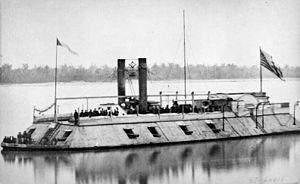Ordered as St. Louis Laid down August 1861 Length 53 m Weight 520.2 tons Draft 1.8 m | Cost $89,000 USD Commissioned January 31, 1862 Construction started August 1861 Displacement 464,500 kg Builder St. Louis | |
 | ||
Launched October 12, 1861 at Carondelet, Missouri Renamed September 8, 1862 as Baron DeKalb | ||
Uss baron dekalb 1861
USS Baron DeKalb (1861) was a City-class ironclad gunboat constructed for the Union Navy by James B. Eads during the American Civil War.
Contents
- Uss baron dekalb 1861
- Built in St Louis Missouri in 1861
- Assigned to Union Army operations
- Reassigned to the Union Navy
- Sunk by mine
- Chronology
- Armament
- References
USS Baron DeKalb, named after General Baron DeKalb of Hüttendorf near Erlangen, in present-day Bavaria, was originally named Saint Louis, and was one of seven City-class ironclads built at Carondelet, Missouri and Mound City, Illinois, for the Western Gunboat Flotilla
These ironclads were shallow draft with a center driven paddle wheel. They were partially armored and slow and very hard to steer in the currents of rivers. This ironclad was also vulnerable to plunging fire and also by hits in their un-armored areas. Called "Pook Turtles" for the designer, they did yeoman service through four years of war and were present at almost every battle on the Mississippi River and its tributaries.
Built in St. Louis, Missouri in 1861
Originally built as St. Louis, the stern wheel casemate gunboat was built by James B. Eads, at the Union Marine Works at Carondelet, Missouri, for the U.S. War Department. She was launched in St. Louis, Missouri, October 12, 1861 and joined the Western Gunboat Flotilla.
Assigned to Union Army operations
During 1862 St. Louis, under the command of Lieutenant L. Paulding USN, was attached to Rear Admiral Andrew Hull Foote's squadron and participated in the Battle of Lucas Bend and the capture of Fort Henry on the Tennessee River (February 6, 1862). She served as flagship for the squadron when it assisted the Union Army at the capture of Fort Donelson on the Cumberland River (February 14–16, 1862). Between April and June 1862, she operated against Fort Pillow, Tennessee.
St. Louis was renamed Baron De Kalb September 8, 1862. This change was apparently in anticipation of the vessel's transfer from the War Department to the Navy Department, there already being a St. Louis in commission with the Navy.
Reassigned to the Union Navy
On October 1, 1862 Baron De Kalb was transferred to the Navy Department. During December 21–28 she took part in the Yazoo Expedition and participated in the action at Drumgould's Bluff (December 28). Four of Baron De Kalb's sailors were awarded the Medal of Honor for their actions in the expedition: Ordinary Seaman Peter Cotton, Captain of the Forecastle Pierre Leon, Boatswain's Mate John McDonald, and Boatswain's Mate Charles Robinson.
During 1863 Baron De Kalb took part in the capture of Arkansas Post (January 10–11); expedition up the White River (January 12–14); Yazoo Pass Expedition (February 20 – April 5); action at Fort Pemberton (March 11–13); action at Haines' Bluff (April 29–2 May, May 18); action at Yazoo City, Mississippi (20–23 May); and the Yazoo River Expedition (24–31 May).
Sunk by mine
On July 13, 1863 Baron De Kalb was sunk by a mine (then called a "torpedo") in the Yazoo River, one mile below Yazoo City, Mississippi.
Chronology
Armament
Like many of the Mississippi theater ironclads, Baron Dekalb had its armament changed multiple times over life of the vessel. To expedite the entrance of Baron DeKalb into service, she and the other City-class ships were fitted with whatever weapons were available; then had their weapons upgraded as new pieces became available. Though the 8 in (200 mm) Dahlgren smoothbore cannons were fairly modern most of the other original armaments were antiquated; such as the 32-pounders, or modified; such as the 42-pounder "rifles" which were in fact, old smoothbores that had been gouged out to give them rifling. These 42-pounder weapons were of particular concern to military commanders because they were structurally weaker and more prone to exploding than purpose-built rifled cannons. Additionally, the close confines of riverine combat greatly increased the threat of boarding parties. The 12-pounder howitzer was equipped to address that concern and was not used in regular combat.
